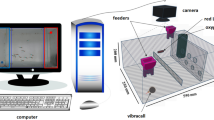Abstract
The behavioral responses of a tilapia (Oreochromis niloticus) school to low (0.13 mg/L), moderate (0.79 mg/L) and high (2.65 mg/L) levels of unionized ammonia (UIA) concentration were monitored using a computer vision system. The swimming activity and geometrical parameters such as location of the gravity center and distribution of the fish school were calculated continuously. These behavioral parameters of tilapia school responded sensitively to moderate and high UIA concentration. Under high UIA concentration the fish activity showed a significant increase (P<0.05), exhibiting an avoidance reaction to high ammonia condition, and then decreased gradually. Under moderate and high UIA concentration the school's vertical location had significantly large fluctuation (P<0.05) with the school moving up to the water surface then down to the bottom of the aquarium alternately and tending to crowd together. After several hours' exposure to high UIA level, the school finally stayed at the aquarium bottom. These observations indicate that alterations in fish behavior under acute stress can provide important information useful in predicting the stress.
Similar content being viewed by others
References
Albert, A., 1973. Selective Toxicity. Chapman and Hall, London.
Almazán-Rueda, P., Schrama, J.W., Verreth, J.A.J., 2004. Behavioural responses under different feeding methods and light regimes of the African catfish (Clarias gariepinus) juveniles.Aquaculture,231(1–4): 347–359.
Beitinger, T.L., 1990. Behavioral reactions for the assessment of stress in fishes.J. Great Lakes Res.,16(2): 495–528.
El-Shafaia, S.A., El-Goharya, F.A., Nasra, F.A., van der Steenb, N.P., Gijzenb, H.J., 2004. Chronic ammonia toxicity to duckweed-fed tilapia (Oreochromis niloticus).Aquaculture,232(1): 117–127.
Hargreaves, J.A., Kucuk, S., 2001. Effects of diel unionized ammonia fluctuation on juvenile hybrid striped bass, channel catfish, and blue tilapia.Aquaculture,195(1–2): 163–181.
Israeli, D., Kimmel, E., 1996. Monitoring the behavior of hypoxia-stressedCarassius auratus using computer vision.Aquacult. Eng.,15(6): 423–440.
Israeli-Weinstein, D., Kimmel, E., 1998. Behavioral response of carp (Cyprinus carpio) to ammonia stress.Aquaculture,165(1): 81–93.
Kane, A.S., Salierno, J.D., Gipson, G.T., Molteno, T.C.A., Hunter, C., 2004. A video-based movement analysis system to quantify behavioral stress responses of fish.Water Res.,38(18): 3993–4001.
Kristiansen, T.S., Ferno, A., Holm, J.C., Privitera, L., Bakke, S., Fosseidengen, J.E., 2004. Swimming behaviour as an indicator of low growth rate and impaired welfare in Atlantic halibut (Hippoglossus hippoglossus L.) reared at three stocking densities.Aquaculture,230(1–4): 137–151.
Lawson, T.B., 1995. Fundamentals of Aquacultural Engineering. Kluwer Academic Publishers, Boston.
McFarlane, W.J., Cubitt, K.F., Williams, H., Rowsell, D., Moccia, R., Gosine, R., McKinley, R.S., 2004. Can feeding status and stress level be assessed by analyzing patterns of muscle activity in free swimming rainbow trout (Oncorhynchus mykiss Walbaum)?Aquaculture,239(4): 467–484.
Nogita, S., Baba, K., Yahagi, H., Watanabe, S., Mori, S., 1988. Acute Toxicant Warning System Based on a Fish Movement Analysis by Use of AI Concept. Artificial Intelligence for Industrial Applications. IEEE AI '88, Proceedings of the International Workshop, Hitachi, Japan, p. 273–276.
Petrell, R.J., Ang, K.P., 2001. Effects of pellet contrast and light intensity on salmonid feeding behaviours.Aquacult. Eng.,25(3): 175–186.
Timmons, M.B., Ebeling, J.M., Wheaton, F.W., Summerfelt, S.T., Vinci, B.J., 2002. Recirculating Aquaculture Systems. 2nd Ed., Northeastern Regional Aquaculture Center, Cayuga Aquaculture Ventures, LLC Ithaca, NY.
Xu, J.Y., Liu, Y., Cui, S.R., Miao, X.W., 2006. Quantifying the swimming activity of multi-fish using computer vision.Trans CSAE (in press)
Author information
Authors and Affiliations
Corresponding author
Additional information
Project (Nos. 2001AA620104 and 2003AA603140) supported by the Hi-Tech Research and Development Program (863) of China
Rights and permissions
About this article
Cite this article
Jian-yu, X., Xiang-wen, M., Ying, L. et al. Behavioral response of tilapia (Oreochromis niloticus) to acute ammonia stress monitored by computer vision. J. Zheijang Univ.-Sci. B 6, 812–816 (2005). https://doi.org/10.1007/BF02842442
Received:
Accepted:
Issue Date:
DOI: https://doi.org/10.1007/BF02842442




